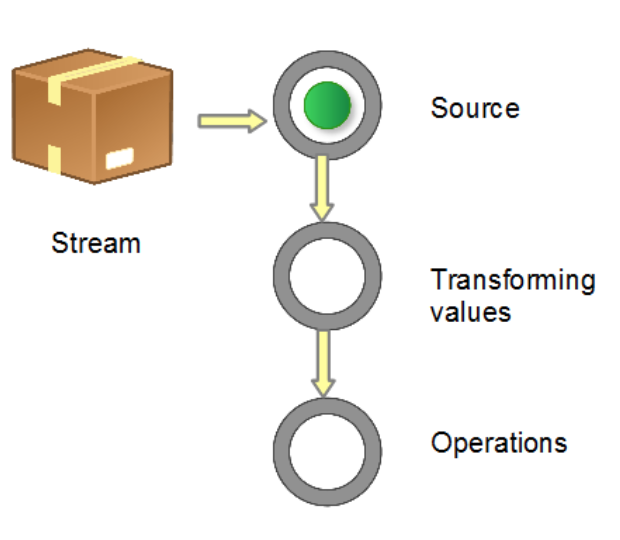前言
java8中提供了stream对集合操作作出了极大的简化,学习了stream之后,我们以后不用使用for循环就能对集合作出很好的操作。
本文将给大家详细介绍关于java8 stream使用的相关内容,下面话不多说了,来一起看看详细的介绍吧
1. 原理
stream 不是集合元素,它不是数据结构并不保存数据,它是有关算法和计算的,它更像一个高级版本的 iterator。
原始版本的 iterator,用户只能显式地一个一个遍历元素并对其执行某些操作;
高级版本的 stream,用户只要给出需要对其包含的元素执行什么操作,比如:
- 所有元素求和
- 过滤掉长度大于 10 的字符串
- 获取每个字符串的首字母
stream 就如同一个迭代器(iterator),单向,不可往复,数据只能遍历一次,遍历过一次后即用尽了,就好比流水从面前流过,一去不复返。
而和迭代器又不同的是,stream 可以并行化操作
stream 的另外一大特点是,数据源本身可以是无限的
2.使用步骤
获取一个数据源(source)→ 数据转换→执行操作获取想要的结果
每次转换原有 stream 对象不改变,返回一个新的 stream对象(可以有多次转换),这就允许对其操作可以像链条一样排列,变成一个管道,如下图所示。

3. stream的构造
|
1
2
3
4
5
6
7
8
9
10
11
12
13
14
15
16
17
18
19
|
public void test4() { stream stream = stream.of("a", "b", "c", 23); stream.foreach(key -> system.out.println(key)); string[] array = new string[]{"abc", "efg"}; stream = stream.of(array); stream = arrays.stream(array); stream.foreach(key -> system.out.println(key)); list<string> list = arrays.aslist(array); stream = list.stream(); //intstream、longstream、doublestream intstream stream2 = intstream.of(1, 2, 3, 3); doublestream stream4 = doublestream.of(1, 2, 3, 3.4); stream2.foreach(key -> system.out.println(key)); stream4.foreach(key -> system.out.println(key)); } |
结果
a
b
c
23
abc
efg
1
2
3
3
1.0
2.0
3.0
4. stream的转换
|
1
2
3
4
5
6
7
8
9
10
11
|
public void test6() { stream stream = stream.of("abc", "def"); string[] array = (string[])stream.toarray(string[]::new); system.out.println(array.length); list<string> list = (list<string>)stream.of("1", "2", "3").collect(collectors.tolist()); string str = stream.of("abc", "mn").collect(collectors.joining()).tostring(); system.out.println(array); system.out.println(list); system.out.println(str); } |
结果
2
[ljava.lang.string;@17f052a3
[1, 2, 3]
abcmn
5.一个 stream 只可以使用一次
|
1
2
3
4
5
|
public void test6_5() { stream stream = stream.of(1, 2, 3, 2); system.out.println("count:" + stream.count()); system.out.println("count:" + stream.count());} |
输出
exception in thread "main" java.lang.illegalstateexception: stream has already been operated upon or closed
at java.util.stream.abstractpipeline.<init>(abstractpipeline.java:203)
at java.util.stream.longpipeline.<init>(longpipeline.java:91)
at java.util.stream.longpipeline$statelessop.<init>(longpipeline.java:572)
at java.util.stream.referencepipeline$5.<init>(referencepipeline.java:221)
at java.util.stream.referencepipeline.maptolong(referencepipeline.java:220)
at java.util.stream.referencepipeline.count(referencepipeline.java:526)
at streamtest.streamtest.test6_5(streamtest.java:68)
at streamtest.streamtest.main(streamtest.java:181)
count:4
6.转换大写
|
1
2
3
4
5
6
7
8
9
|
public void test7() { list<string> list = arrays.aslist("a", "mnm"); list<string> result = list.stream(). map(string::touppercase). collect(collectors.tolist()); system.out.println(list); system.out.println(result); } |
输出
[a, mnm]
[a, mnm]
7.平方
|
1
2
3
4
5
6
7
8
9
|
public void test8() { list<integer> list2 = arrays.aslist(1, 2, 4); list<integer> list3 = list2.stream(). map(key -> key * key). collect(collectors.tolist()); system.out.println(list2); system.out.println(list3); } |
输出
[1, 2, 4]
[1, 4, 16]
8.找偶数
|
1
2
3
4
5
6
7
8
|
public void test8_5() { list<integer> list2 = arrays.aslist(1, 2, 4); list<integer> list3 = list2.stream(). filter(key -> key % 2 == 0). collect(collectors.tolist()); system.out.println(list2); system.out.println(list3); } |
输出
[1, 2, 4]
[2, 4]
9. 区间值
|
1
2
3
4
5
6
|
public void test5() { system.out.println("\n"); intstream.range(1, 3).foreach(system.out::println); system.out.println("\n"); intstream.rangeclosed(1, 3).foreach(system.out::println); } |
结果
1
2
1
2
3
10.并发
|
1
2
3
|
public void test5_pa() {intstream.rangeclosed(1, 10).parallel().foreach(system.out::println);} |
输出
3
7
1
5
2
8
10
6
9
4
11. 新的stream继续操作
|
1
2
3
4
5
6
7
8
|
public void test6_6() { stream.of("one", "two", "three", "four") .filter(e -> e.length() > 3) .peek(e -> system.out.println("filtered value: " + e)) .map(string::touppercase) .peek(e -> system.out.println("mapped value: " + e)) .collect(collectors.tolist()); } |
结果
filtered value: three
mapped value: three
filtered value: four
mapped value: four
12. optional
|
1
2
3
4
5
6
7
8
9
10
11
12
13
14
15
16
17
18
19
20
21
|
public static void print(string text) { system.out.println("<<<<<<"); system.out.println(optional.ofnullable(text)); list<string> obj = new arraylist<>(); optional.ofnullable(text).ifpresent(system.out::println); system.out.println(">>>>>>>>>>>>\n"); } public static int getlength(string text) { return optional.ofnullable(text).map(string::length).orelse(-1); } public void test14() { string stra = " abcd ", strb = null; print(stra); print(""); print(strb); system.out.println(getlength(stra)); system.out.println(getlength("")); system.out.println(getlength(strb)); } |
结果
<<<<<<
optional[ abcd ]
abcd
>>>>>>>>>>>>
<<<<<<
optional[]
>>>>>>>>>>>>
<<<<<<
optional.empty
>>>>>>>>>>>>
6
0
-1
13. 字符串拼接、最值、求和、过滤
|
1
2
3
4
5
6
7
8
9
10
11
12
13
14
15
16
|
public void test15() { string concat = stream.of("a", "b", "c").reduce("", string::concat); system.out.println("concat:" + concat); double minvalue = stream.of(-1.5, 1.0, -3.0, -2.0).reduce(double.max_value, double::min); system.out.println("min:" + minvalue); int sumvalue = stream.of(1, 2, 3, 4).reduce(0, integer::sum); system.out.println("sum1:" + sumvalue); int sumvalue2 = stream.of(1, 2, 3, 4).reduce(integer::sum).get(); system.out.println("sum2:" + sumvalue2); concat = stream.of("a", "b", "c", "d", "e", "f").filter(x -> x.compareto("z") > 0).reduce("", string::concat); system.out.println("concat:" + concat); } |
结果
concat:abc
min:-3.0
sum1:10
sum2:10
concat:ace
14. limit, skip
|
1
2
3
4
5
6
|
public void test16() { list<person> persons = new arraylist<>(); intstream.range(1, 1000).foreach(key->persons.add(new person(key, "jihite:" + key))); list<string> personlist = persons.stream().map(person::getname).limit(10).skip(3).collect(collectors.tolist()); system.out.println(personlist); } |
输出
[jihite:4, jihite:5, jihite:6, jihite:7, jihite:8, jihite:9, jihite:10]
15.找出最长一行的长度
|
1
2
3
4
5
6
7
8
9
10
|
public void test19() throws ioexception { string path = "**/person.java"; bufferedreader br = new bufferedreader(new filereader(path)); int longest = br.lines() .maptoint(string::length) .max() .getasint(); br.close(); system.out.println(longest); } |
输出
16.找出全文的单词,转小写,并排序
|
1
2
3
4
5
6
7
8
9
10
11
12
13
14
|
public void test20() throws ioexception { string path = "**/person.java"; bufferedreader br = new bufferedreader(new filereader(path)); list<string> words = br.lines() .flatmap(line->stream.of(line.split(" "))) .filter(word->word.length()>0) .map(string::tolowercase) .distinct() .sorted() .collect(collectors.tolist()); br.close(); system.out.println(words); words.foreach(key-> system.out.println(key)); } |
输出
*
*/
/**
//
2018/10/24
21:40
=
@author:
@date:
@description:
class
getname()
int
name)
参考
总结
以上就是这篇文章的全部内容了,希望本文的内容对大家的学习或者工作具有一定的参考学习价值,如果有疑问大家可以留言交流,谢谢大家对服务器之家的支持。
原文链接:http://www.cnblogs.com/kaituorensheng/p/9852462.html

















